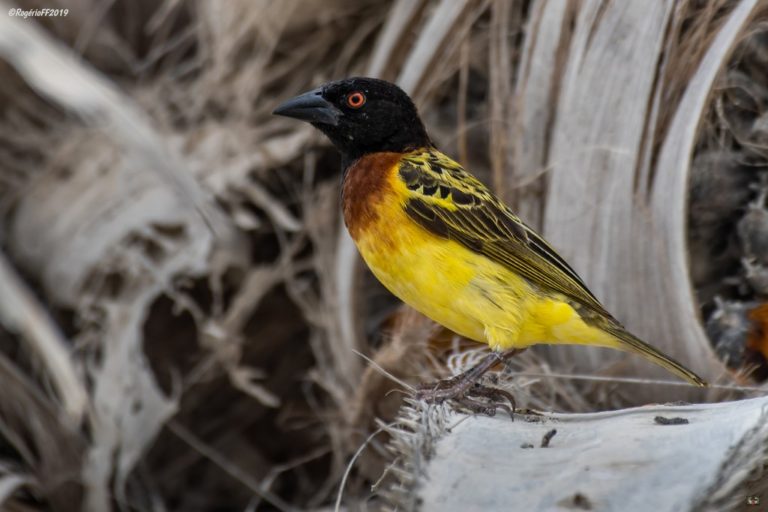Birdfinding.info ⇒ The southwestern form of Village Weaver is locally common in it limited range, including the capital cities Brazzaville and Kinshasa, and outlying areas of Luanda.
“Mottled Weaver”
Textor cucullatus collaris
Family: Ploceidae
West-central Africa. Inhabits various wooded, semiopen, and edge habitats, including human settlements.

Approximate distribution of the forms of Village Weaver. © BirdLife International 2018
Resident in forests and savannas from western Gabon to southwestern Angola.
The full extent of its range is not well-documented. In western Gabon, it occurs north at least to Komo-Oceán and Ogooué et Lacs, but apparently not to Libreville (where the “Hooded Weaver” occurs). In the Democratic Republic of the Congo, it occurs east at least to Équateur Province. In southwestern Angola, it occurs south at least to the coastal range of Namibe.
Breeds colonially in trees, including palms. The nest is a woven mass suspended from a branch or frond, entered from below.
Identification
Like other forms of Village Weaver: a large, stocky, heavy-billed weaver with vivid red eyes, that is often found in agricultural and settled areas. The breeding male differs from similar forms in the amount of chestnut on its chest, black nape and in spotted back.
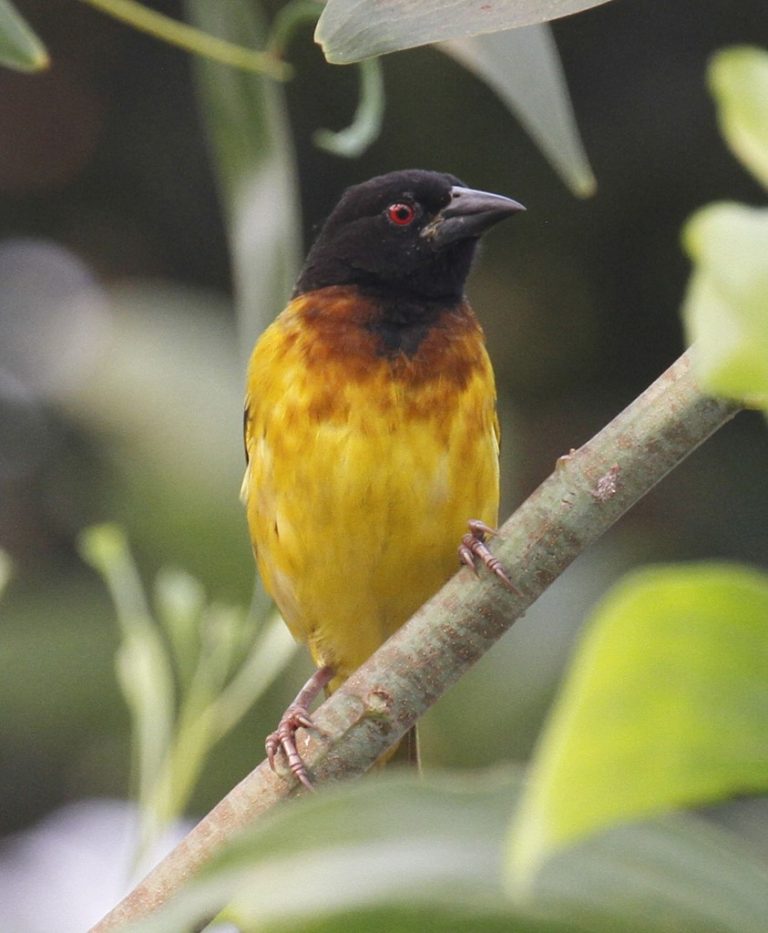
“Mottled Weaver”, T. c. collaris, male in breeding plumage. (Brazzaville, Congo Republic; August 17, 2017.) © Robin Gwen Agarwal
Males in breeding plumage are bright-yellow overall, with a full black hood and extensive black-and-chestnut bib. The black of the hood projects down narrowly below the throat, and the rest of the bib is chestnut.
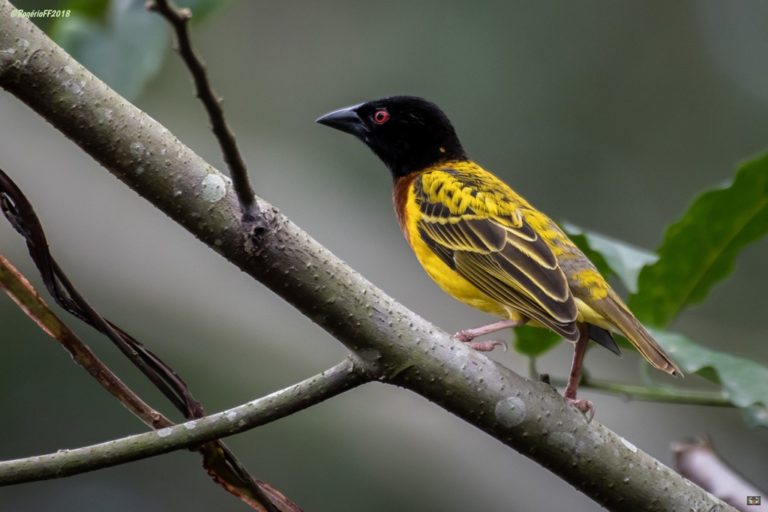
“Mottled Weaver”, T. c. collaris, male in breeding plumage. (Bula-Atumba, Angola; October 6, 2018.) © Rogério Ferreira
The back is yellow with black streaks or spots—unlike the backs of “Hooded” and “Layard’s”, which are yellow with a bold black V pattern.

“Mottled Weaver”, T. c. collaris, basic plumage. (Kwanza Lodge, Luanda, Angola; August 12, 2018.) © Ron Hoff Dollyann Myers
As in other forms of Village Weaver, females, immatures, and nonbreeding males are comparatively drab and nondescript, but variable—often best recognized by their large bills and red eyes.

“Mottled Weaver”, T. c. collaris, basic plumage. (Ícolo e Bengo, Angola; October 14, 2018.) © Rogério Ferreira
They can be either olive or grayish overall, variably suffused with pale lemon yellow, mainly on the head, throat, and wings—often with a distinct yellow brow.

“Mottled Weaver”, T. c. collaris, basic plumage. (Loango National Park, Gabon; December 5, 2012.) © Matt Muir
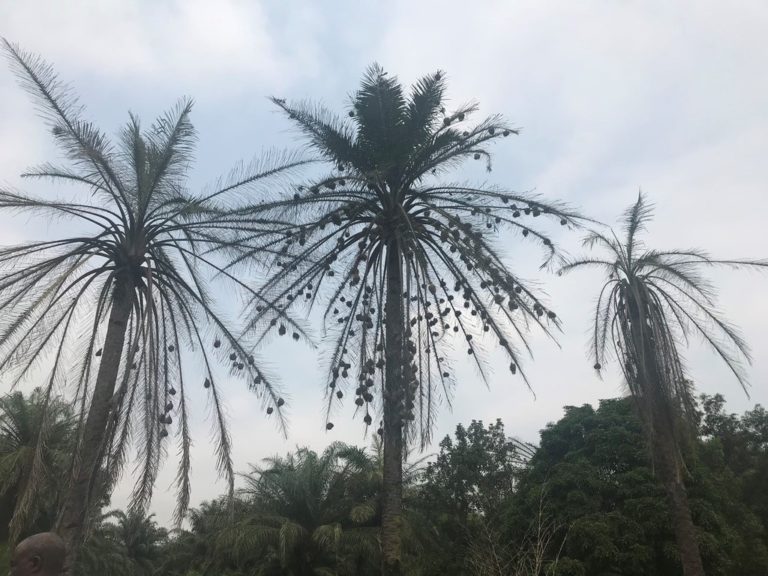
“Mottled Weaver”, T. c. collaris, colony. (Kinshasa, D.R. Congo; June 20, 2021.) © Janna Wisniewski
Voice. Vocalizations are not known to differ remarkably from those of other Village Weaver forms: i.e., variable chatter consisting of clicks, buzzes, whistles, etc.
Notes
Monotypic form, one of four or five potentially distinct forms of Village Weaver (cucullatus).
See below for a comparison of the “Mottled Weaver” with the “Hooded Weaver”.
Cf. “Hooded Weaver”. The “Hooded” and “Mottled” forms of Village Weaver are very similar and could potentially intergrade where their ranges approach one another in northwestern Gabon. Males in breeding plumage are similar because both have full black hoods. They differ in the coloration on the chest and nape, and in the pattern on their backs.
Chest: The breeding male “Hooded Weaver” typically has a narrow chestnut bib or border beside the black on its throat, whereas “Mottled” has a broad chestnut bib that covers a large portion of the chest.
Nape: The breeding male “Hooded Weaver” typically has a narrow chestnut band on the nape, whereas “Mottled” has a crisply defined black hood that contrasts with its back.
Back: The breeding male “Hooded Weaver” typically has a yellow back with broad black bars or patches on either side of it, whereas “Mottled” has a mostly yellow back with small black spots.
More Images of the “Mottled Weaver”

“Mottled Weaver”, T. c. collaris, male in breeding plumage. (Malonda Lodge, Congo Republic; October 31, 2015.) © Bernard Guévorts
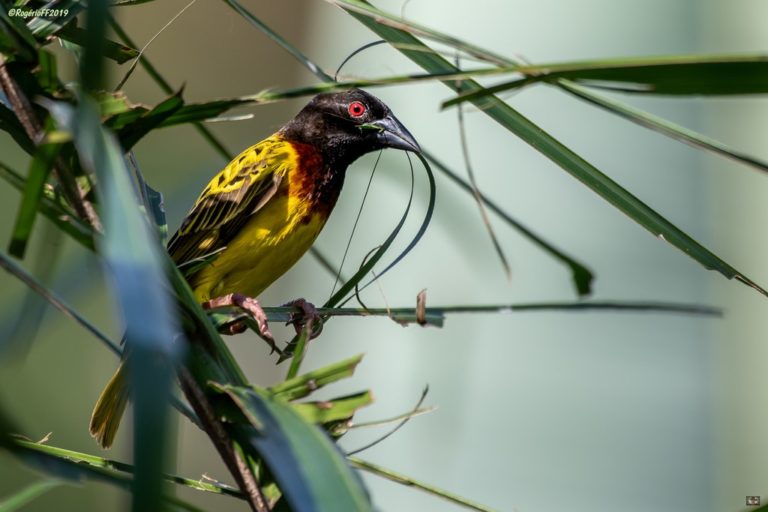
“Mottled Weaver”, T. c. collaris, male in breeding plumage. (Bula-Atumba, Angola; February 2, 2019.) © Rogério Ferreira
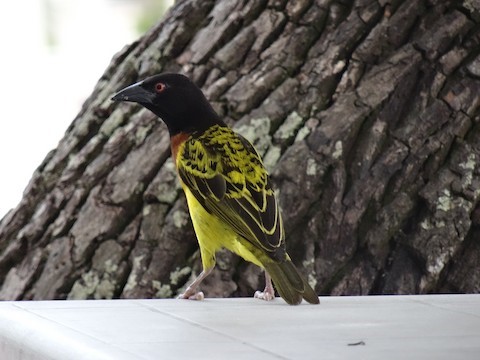
“Mottled Weaver”, T. c. collaris, male in breeding plumage. (Cape Lopez, Gabon; October 19, 2015.) © James Richardson

“Mottled Weaver”, T. c. collaris, basic plumage. (Loango National Park, Gabon; December 5, 2012.) © Matt Muir
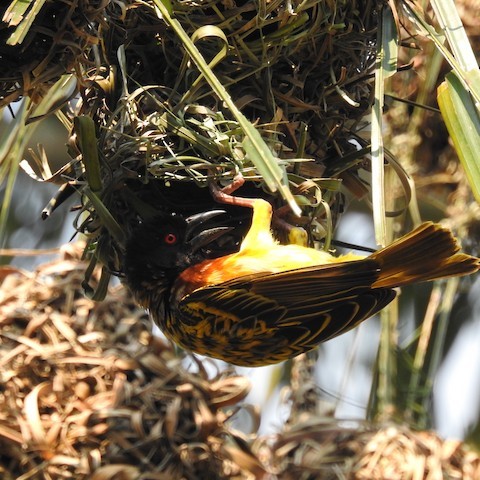
“Mottled Weaver”, T. c. collaris, male in colony. (Parc de la Vallee de la N’Sele, Kinshasa, D.R. Congo; August 30, 2020.) © Vanessa Filippini
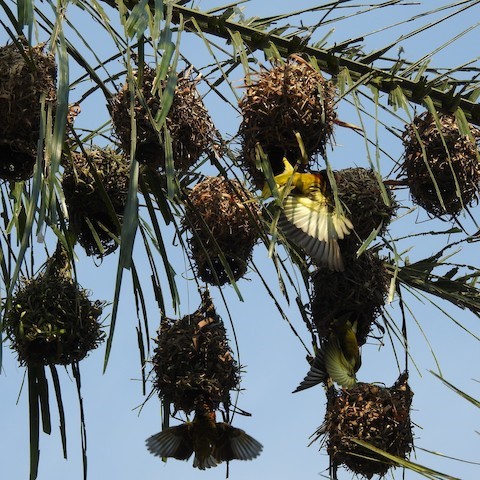
“Mottled Weaver”, T. c. collaris, males in colony. (Parc de la Vallee de la N’Sele, Kinshasa, D.R. Congo; August 30, 2020.) © Vanessa Filippini
References
BirdLife International. 2018. Ploceus cucullatus. The IUCN Red List of Threatened Species 2018: e.T22718921A132122615. https://dx.doi.org/10.2305/IUCN.UK.2018-2.RLTS.T22718921A132122615.en. (Accessed April 23, 2022.)
Borrow, N., and R. Demey. 2004. Birds of Western Africa. Princeton University Press.
eBird. 2022. eBird: An online database of bird distribution and abundance. Cornell Lab of Ornithology, Ithaca, N.Y. http://www.ebird.org. (Accessed April 23, 2022.)
Sinclair, I., and P. Ryan. 2003. Birds of Africa South of the Sahara. Princeton University Press.
van Perlo, B. 1999. Birds of Southern Africa. Princeton University Press, Princeton, N.J.
van Perlo, B. 2002. Birds of Western and Central Africa. Princeton University Press.
Xeno-Canto. 2022. Village Weaver – Ploceus cucullatus. https://xeno-canto.org/species/Ploceus-cucullatus. (Accessed April 23, 2022.)
